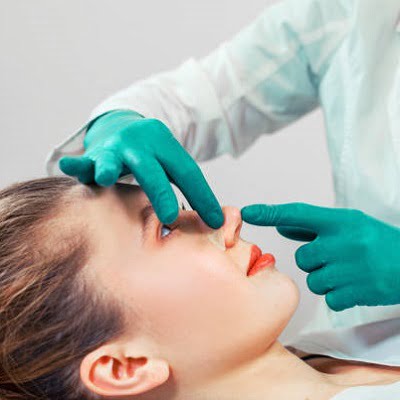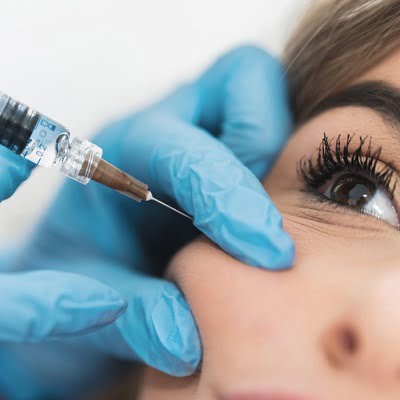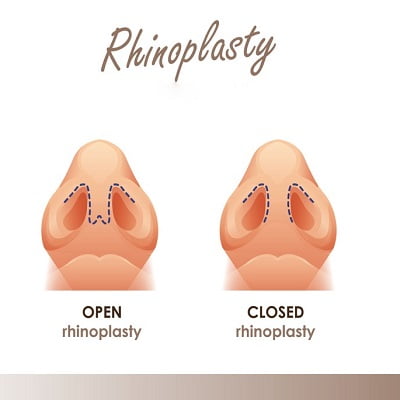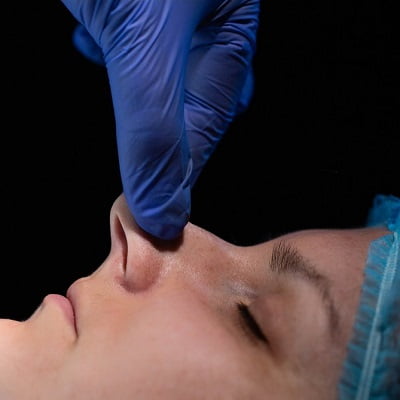“Will septoplasty change the appearance of my nose?” is a typical question that many ENT physicians get. People are concerned that the operation would alter the curvature of their nose, affecting the overall appearance of their face. They resist septoplasty because they are afraid it may change their face features. If you are thinking about having a septoplasty in Islamabad, you might be concerned about how the procedure will affect your nose’s appearance.
What Is Septoplasty?
Septoplasty is a surgical technique that straightens a deviated septum. A deviated septum occurs when a portion of the septum deviates to one side of the nasal passageways. People commonly refer to deviated septums as crooked noses.
A deviated septum makes breathing difficult because airflow enters the nasal passages unevenly. The issue worsens when the individual has an upper respiratory infection and sinusitis.
What Is Septal Deviation?
One of the most prevalent is septal deviation. The septum is a midline structure that separates the nose into right and left halves. It consists of two distinct bones and a big cartilage component in the shape of a quadrangle. It can be deviated and obstructive in a wide range of settings and materials.
The caudal area is at the nose’s tip, whereas the posterior or cephalic portion is farther back.
What Are The Indications For Septoplasty?
Septoplasty is advised for those who have symptoms of a deviated septum, such as nasal congestion, trouble breathing, snoring, recurring sinus infections, and face pain or pressure. Trauma, congenital malformations, or nasal development irregularities can all create a deviated septum, which can have a substantial impact on the quality of life for those who suffer from it.
Prior to undergoing septoplasty, patients are evaluated comprehensively by an otolaryngologist to establish the degree of the deviation and if septoplasty is the best course of therapy.
Does Septoplasty Change The Appearance Of The Nose?
Yes, septoplasty improves the look of the nose. The nasal septum plays an important function in establishing the shape and structure of the nose. It is also useful in determining the nose’s height and breadth. As a result, any changes to the nasal septum will have an immediate impact on the nose’s overall look.
Most individuals choose septoplasty to modify the look of their nose. When the doctor corrects the septum deviation, the nose shape changes significantly, becoming more symmetrical. In addition, straightening the nose removes any obstruction, allowing the client to breathe freely.
Types Of Approaches To Septoplasty
We utilize the CT and Endoscope data to decide the optimal method to septoplasty. Caudal deviations necessitate a full transfixion incision, but posterior deviations can be treated with a hemi-transfixion or killian’s incision.
Full transfixion Septoplasty
In this procedure, an incision is created internally using a transfixion method, and the septum is accessible through both nostrils. This provides entire exposure of the deviated septum, allowing the surgeon to perform precise adjustments to straighten the septum and enhance airflow.
Full transfixion septoplasty allows great visibility of the nasal tissues and is best suited for more complicated septal abnormalities. Caudal deviation frequently results in asymmetric nostrils when viewed from below. If this is the case, complete transfixion, when done correctly, can assist to make the nostrils more symmetric.
It is also used to treat a tension nose deformity, which can cause a 1 mm regression of the nasal tip. Usually imperceptible.
Hemitransfixion Septoplasty
In hemi-transfixion septoplasty, an incision is made on one side of the septum to access and repair the deviated area.
This procedure is less invasive than complete transfixion septoplasty, yet it still allows for successful septal deviation correction. The incision is often well covered within the nasal cavity, resulting in minimal apparent scarring after surgery. It is utilized when the caudal septum is not implicated.
Killian’s Incision Septoplasty
Killian’s incision is a surgical method that includes making an incision near the intersection of the cartilaginous and bony septums. This method gives access to both the anterior and posterior sections of the deviated septum, enabling for complete correction of a largely bony distortion.
Killian’s incision septoplasty is useful for treating septal abnormalities that are mostly situated in the posterior nasal cavity.
What Happens To Subtle Changes In Nasal Shape?
While the primary goal of septoplasty is to improve nasal function by straightening the septum and enhancing airflow, the operation may cause modest changes in nose form. These changes are often minor and are mostly connected to changes in the inside nasal structures rather than the exterior esthetic appearance.
Some of the modest modifications that can occur with different septoplasty methods are:
- Straightening the septum can help to enhance nasal symmetry, especially if the deviation was creating noticeable nasal asymmetry. However, this transformation is largely internal and may have little influence on the nose’s outward look. The most visible external manifestations are the straightening/relaxation of the nostrils and columella, as well as the repair of a strained nose.
- By correcting the septal deviation and regulating nasal airflow, septoplasty can indirectly enhance nasal shape and profile. Improved airflow can minimize nasal congestion and relieve strain on the nasal tissues, resulting in a more balanced and harmonious look.
- Septoplasty is intended to preserve the nose’s natural proportions and attractiveness while treating functional difficulties associated with septal deviation. Surgeons try to retain the structural integrity of the nose and ensure that any modifications made during septoplasty are modest and have little influence on the overall nasal appearance.
It is important to emphasize that the changes in nasal shape after septoplasty are minor and are meant to improve nasal function rather than altering exterior esthetic aspects. Septoplasty is not meant to remedy external cosmetic deviations such as a crooked nose or a nasal hump, which are normally addressed by rhinoplasty.
Who Are The Ideal Candidates For Septoplasty?
Anyone can be an ideal candidate for septoplasty if they are suffering from any of the following disorders might consider having Septoplasty:
- Blockage in one or both nostrils- Shifting the septum to one side of the nose causes a blockage in one or both nostrils. The individual is unable to breathe freely because the nostrils do not allow air to enter.
- Frequent sinusitis and blocked nose- As less air enters the nostrils, there is a higher risk of sinus infections and post-nasal drip.
- High risk of nosebleeds- Nasal dryness increases the possibility of a nosebleed.
- Unable to sleep properly- Due to significant nasal congestion, the individual may have undisturbed sleep. This leads to breathing via the mouth, which can cause mouth dryness.
What Is The Difference Between Septoplasty And Rhinoplasty?
People frequently mistake Septoplasty with Rhinoplasty, as both are forms of nasal surgery. Both are independent treatments that are suggested for different reasons.
| Septoplasty |
Rhinoplasty |
- Corrects the septal deviation that causes other nose difficulties.
|
- Treats nasal symptoms while also improving the look of the nose.
|
- The doctor does not touch the outward form.
|
- The procedure is intended to modify the overall contour of the nose.
|
- Simply straightens the septum of the nose.
|
- Reshapes the nose based on its size, symmetry, and shape.
|
How To Prepare For Septoplasty?
Preparation is necessary for septoplasty. It reduces the risk of infection and postoperative hemorrhage. Following a physical examination, the doctor may propose specific diagnostic tests that the patient must do. Some of these diagnostic techniques include blood testing and magnetic resonance imaging.
In addition, the doctor may advise you to avoid taking some medications, such as aspirin, because they might thin the blood. Before surgery, the patient must cease smoking and consuming alcohol. Furthermore, vitamins and herbal medicines might interfere. Tell your doctor about it.
What Happens During The Procedure Of Septoplasty?
Here is a step-by-step process for septoplasty.
- Step 1: Administer anesthetic.
An anesthetist extensively examines the patient to see whether there will be any hazards after delivering the anesthetic. Anesthetists provide general or local anesthesia via an intravenous line or injection.
- Step 2: Making incisions.
After determining that the patient is fully unconscious, the doctor makes multiple incisions. A professional in septoplasty creates incisions that leave little scars. Typically, the ENT specialist makes an incision across the columella, a tissue that divides both nostrils.
- Step 3: Separate the mucosal lining.
The doctor uses the incision to reach the mucosal lining that protects the septum. The doctor then pulls the lining from one side of the septum. This is an extremely crucial step since any injury to the lining might cause a hole in the mucosal lining. The doctor repeats it from the other side.
- Step 4: Correcting the deviated septum.
After raising the deviated septum, the doctor straightens it to fix the deviation. Following this, the doctor will realign the mucosal lining.
- Step 5: Closing the wound with stitches
The doctor next restores the mucosal lining and secures it with dissolvable sutures. Nasal packing is inserted into the nose to avoid nosebleeds. It also prevents the nose from shifting.
How Long Does It Take To Fully Recover After Septoplasty?
After the Septoplasty treatment, the client can return to their normal activities within two days. However, it is best to talk with a doctor before returning to work. The total recovery time for septoplasty is determined on the magnitude of the deviation, the method employed, and the patient’s healing capacity. For example, a patient is more likely to recover faster if he has an endoscopic septoplasty rather than a standard septoplasty. Normally, it takes the patient around 7 days to fully recover. In certain circumstances, it may take a few more days.
What Are Some Postoperative Instructions To Follow After Septoplasty?
After surgery, it is typical to have slight discomfort and nasal congestion. Fortunately, they resolve on their own, and the patient is able to breathe freely within a few days.
The directions issued by the ENT specialist are for the following purposes:
- How to care for the wounds and scars after surgery.
- To minimize pain and infection risk, which medications should be applied to the surgical site or taken orally?
- What sort of diet to follow to speed up the healing?
- When to go to the doctor for a follow-up.
What Are Some Do’s And Don’ts To Follow After Septoplasty?
Here is a checklist of Dos and Don’ts that doctors present before discharge and advise patients to follow carefully for a speedy recovery.
| Do’s |
Don’ts |
- Rest thoroughly during the first 24 hours of recuperation.
- Sneeze via the mouth rather than the nose.
- To reduce discomfort and swelling, use an ice or cold gel pack around the incision site.
- While sleeping, place two pillows beneath your head.
- To avoid infection, spend as much time as possible indoors.
- Shower only after a full consultation with your doctor.
|
- Even if you accidentally touch or massage your nose, refrain from doing so.
- Avoid blowing your nose as often as possible to lessen the chance of bleeding.
- Restrict intense activities that may produce adverse effects, such as bending or participating in sports.
- Do not lie flat on your back in the early days of healing.
- Avoid environments that are dusty or smoky.
- Do not overstrain or apply unnecessary pressure on the face.
|
What Are Some Possible Side Effects That Can Occur After Septoplasty?
Patients should be aware of the potential risks and consequences of septoplasty before deciding whether or not to have the procedure. Pristyn Care ENT doctors highlight the potential issues to watch out for before surgery. These are some of the adverse effects that might occur, but there could be others as well.
- Risk of infection at the incision site.
- Possible risk of nose bleeding
- Hole in the septum.
- Loss of taste and scent.
- Upper jaw numbness is temporary.
- Hoarseness of Voice
- Bruising and soreness on the face.
- Swelling around your eyes
- Spinal fluid leaking.
- Risks of anesthesia
- Persistence of prior symptoms even after surgery
- Unwanted alteration in the contour of the nose
- Septal hematoma is the collection of blood in the nasal passages.
- Toxic Shock Syndrome
Why Choose SKN Cosmetics For Septoplasty In Islamabad!
Septoplasty is an effective surgical treatment for straightening a deviated septum and restoring nasal function in people who are suffering from nasal blockage symptoms. While septoplasty can cause small changes in nasal form, these alterations are mostly internal and are intended to improve nasal airflow and symmetry.
Patients who have septoplasty might expect enhanced nasal function and respiration while retaining the nose’s outward look. Consult with a board-certified otolaryngologist or face plastic surgeon to explore the criteria for septoplasty and the probable results depending on your specific requirements and aspirations.
Since 2014, SKN Cosmetics Clinic in Islamabad has performed over 15,000 septoplasty procedures to repair deviated septums. Give us a call or complete the short form below to discuss the best route to your solution.
Final Verdicts!
A common surgical procedure known as a septoplasty can help with breathing and relieve symptoms brought on by a deviated septum. It is not intended to change the nose’s appearance, though it might slightly alter the nose’s shape. It is crucial to speak with a licensed and experienced surgeon if you are thinking about having a septoplasty or have any questions about the procedure.









